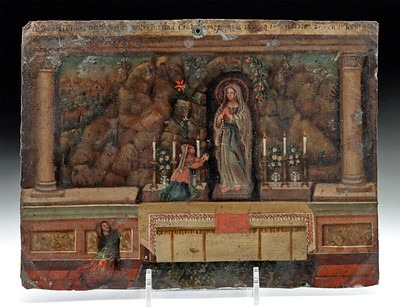Four 18th C Engravings - Rhytons in Hamilton Collection
Lot 177
About Seller
Artemis Gallery
686 S Taylor Ave, Ste 106
Louisville, CO 80027
United States
Selling antiquities, ancient and ethnographic art online since 1993, Artemis Gallery specializes in Classical Antiquities (Egyptian, Greek, Roman, Near Eastern), Asian, Pre-Columbian, African / Tribal / Oceanographic art. Our extensive inventory includes pottery, stone, metal, wood, glass and textil...Read more
Categories
Estimate:
$800 - $1,200
Absentee vs Live bid
Two ways to bid:
- Leave a max absentee bid and the platform will bid on your behalf up to your maximum bid during the live auction.
- Bid live during the auction and your bids will be submitted real-time to the auctioneer.
Bid Increments
| Price | Bid Increment |
|---|---|
| $0 | $25 |
| $300 | $50 |
| $1,000 | $100 |
| $2,000 | $250 |
| $5,000 | $500 |
| $10,000 | $1,000 |
| $20,000 | $2,500 |
| $50,000 | $5,000 |
| $100,000 | $10,000 |
| $200,000 | $20,000 |
About Auction
By Artemis Gallery
Jun 15, 2023
Set Reminder
2023-06-15 10:00:00
2023-06-15 10:00:00
America/New_York
Bidsquare
Bidsquare : VARIETY Ancient, Ethno, Native American, Fine Art
https://www.bidsquare.com/auctions/artemis-gallery/variety-ancient-ethno-native-american-fine-art-12990
Antiquities, ethnographic, native american and fine art from cultures encompassing the globe. Artemis Gallery info@artemisgallery.com
Antiquities, ethnographic, native american and fine art from cultures encompassing the globe. Artemis Gallery info@artemisgallery.com
- Lot Description
Europe, France, ca. 18th century. Four large antique engravings of distinct ancient animal rhytons from "Collection of Etruscan, Greek, and Roman antiquities from the cabinet of the Honble. Wm. Hamilton His Britannick Maiesty's envoy extraordinary at the Court of Naples" ("Antiquites etrusques, grecques et romaines tirees du cabinet de M. Hamilton, envoye extraordinaire de S.M. Britannique en Cour de Naples"). Plates, initials, and head- and tailpieces variously engraved by Ant. Cardon, Nolli, Carmine Pignatari, Filip. de Grado, and Dufrenoi, after Giuseppe Bracci, Filip. de Grado, Edmondo Beaulieu, Gio. Bat. Tierce, Aniel. Lamberti, and R. Beaulieu. Sir William Hamilton was a British ambassador to the Kingdom of Naples during the period of Naples' "Golden Age "who was fascinated by the excavations of Pompeii and Herculaneum, as well as an avid collector of classical antiquities, especially Greek vases. Size (sheets): 19.625" L x 15.4" W (49.8 cm x 39.1 cm)
According to rare book seller AbeBooks, "Hamilton's collection of ancient vases, assembled by him after his appointment to the court of Naples in 1764, was first illustrated, described, and published between 1776 and 1777. Pierre Francois Hugues, an authority on ancient art, had introduced Hamilton to the Porcinari family, the owners of a large collection of ancient classical vases which Hamilton bought and enlarged, and then sold to the British Museum in 1772. Before their shipment of England, all the objects were listed, drawn and described under the supervision of the brilliant but unscrupulous baron. The work was finely illustrated with hand-colored engraved plates whose influence on neo-classical design and taste was to be profound (Dictionary of Art). One of the explicit aims of the work was to discover the proportions of ancient vases in order to aid in their true reproduction, and indeed its influence on Josiah Wedgewood was significant. Within barely a year of the publication of the first volume Josiah Wedgwood had opened his pottery works, Etruria, in Staffordshire, and thrown six black basalt first day vases based on vases in Hamiltons publication. Countless other subsequent Wedgwood articles and designs were inspired by the work... In 1772 Hamilton was made a knight of the Bath and elected a fellow of the Society of Antiquaries; he and his wife arrived back in Naples early in 1773, after travelling via Vienna, Venice, Florence, and Rome. Believing that he had exhausted the supply of fine Greek vases, Hamilton did not resume collecting until 1789, when he began amassing what would become his second collection of vases. This collection was fully described in Collection of Engravings from Ancient Vases (4 vols., 1791-95), edited with illustrations by Johann Heinrich Wilhelm Tischbein, director of the Naples art academy. Far less expensive than the Antiquitandeacute's, the volumes of these vase engravings, which were soon republished in various affordable editions, had considerable influence on public taste and on artists such as John Flaxman and Henry Fuseli."
Provenance: private Rancho Mirage, California, USA collection, by inheritance in 2020; ex-Dr. TDR Berreth, California, USA, acquired before 1982
All items legal to buy/sell under U.S. Statute covering cultural patrimony Code 2600, CHAPTER 14, and are guaranteed to be as described or your money back.
A Certificate of Authenticity will accompany all winning bids.
We ship worldwide and handle all shipping in-house for your convenience.
#179142Expected age wear with slight toning, areas of foxing, minute losses/tears (most to peripheries), and pinholes to left edge from former binding. Images are still quite vivid. Strong plate marks.Condition
- Shipping Info
-
All shipping is handled in-house for your convenience. Your invoice from Artemis Gallery will include shipping calculation instructions. If in doubt, please inquire BEFORE bidding for estimated shipping costs for individual items.
-
- Buyer's Premium



 EUR
EUR CAD
CAD AUD
AUD GBP
GBP MXN
MXN HKD
HKD CNY
CNY MYR
MYR SEK
SEK SGD
SGD CHF
CHF THB
THB

















